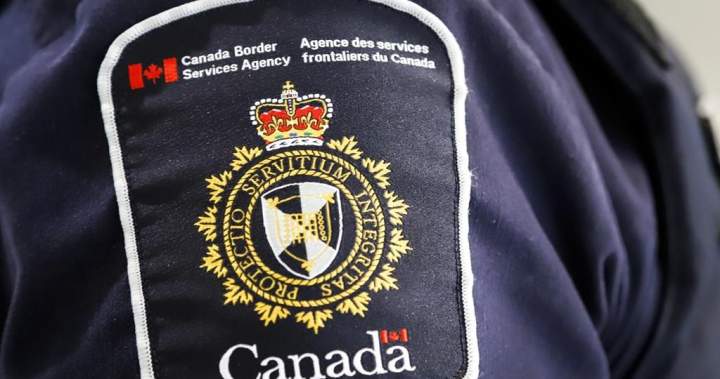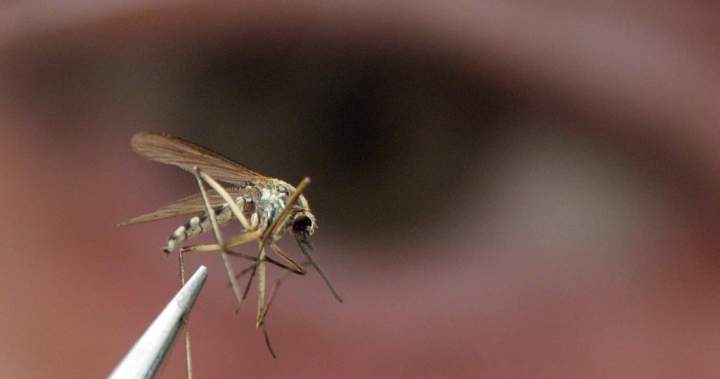Uncategorized
Cocaine found in commercial truck seized by border officials trying to enter Canada

The CBSA (Canada Border Services Agency) say almost 190 kilograms of suspected cocaine was seized by border officials at the Ambassador Bridge in Windsor, Ont.
On May 23, CBSA said border officers intercepted a commercial truck coming into Canada from the United States where 187.5 kilograms of suspected cocaine was found.
In a secondary examination of the trailer, CBSA said two suitcases and five garbage bags were discovered — containing 161 bricks of suspected cocaine.

Get daily National news
Get the day’s top news, political, economic, and current affairs headlines, delivered to your inbox once a day.
The value of the cocaine is estimated to be approximately $23.4 million, CBSA said.
The drugs were seized and a 55-year-old driver from Richmond Hill, Ont. was arrested and transferred to the RCMP.
CBSA said the driver was charged by the RCMP with importation of cocaine and possession of cocaine for the purpose of trafficking.
“The CBSA is continually adapting to be in a position to stop criminals by disrupting their evolving smuggling and concealment attempts,” said Michael Prosia with CBSA. “We use all tools and intelligence at our disposal to stop narcotics from reaching our streets.”
Another 161 bricks of suspected cocaine was seized last month at the Blue Water Bridge port of entry in Point Edward, Ont. Border agents said a commercial truck arrived from the United States and the bricks were contained in six boxes. A 27-year-old Brampton man was arrested in that case.
© 2025 Global News, a division of Corus Entertainment Inc.
Uncategorized
Blue Jays giving Proline players much to ponder

The Toronto Blue Jays are giving Proline players plenty to ponder these days.
Toronto returned from the all-star break in impressive fashion, sweeping the San Francisco Giants over the weekend. The Jays opened the series with a 4-0 victory Friday night before finishing up with wins by scores of 6-3 and 8-6.
According to the Ontario Lottery and Gaming Corp., 69 per cent of players backed Toronto’s win Saturday, with 53 per cent having the Blue Jays at +1.5 runs. Seventy-nine per cent had them over at 7.5.
Related Videos
Sunday’s series-ending victory was supported by 63 per cent of bettors while 51 per cent had Toronto +1.5 runs. But only 48 successfully had the Jays over at 8.5.

Get breaking National news
For news impacting Canada and around the world, sign up for breaking news alerts delivered directly to you when they happen.
Heading into the second half of the baseball season, the Los Angeles Dodgers are the top World Series outright pick at 32 per cent, followed by Toronto at 21 per cent. The Detroit Tigers are a distant third at 11per cent.
Toronto is a solid 62 per cent pick to win the American League East outright, comfortably ahead of the New York Yankees (21 per cent).
Meanwhile, in golf, American Scottie Scheffler cemented his status as the world’s top-ranked player by winning the British Open by four strokes. Just 12 per cent of bettors had Scheffler winning the event, while 29 per cent had him earning a top 10 finish.
This report by The Canadian Press was first published July 23, 2025.
© 2025 The Canadian Press
Uncategorized
West Nile virus is back. Where it’s been found, and what you should know

West Nile virus has returned to Canada for another season, with detections in mosquitoes in multiple regions of Ontario in the past week, including in Toronto.
Niagara Region Public Health confirmed Tuesday that West Nile virus had been detected in mosquitoes in Welland, Ont., while Toronto and York Region reported their first positive cases in the insects late last week.
No human cases of the virus have been reported in Canada as of Wednesday, but that isn’t stopping health-care professionals from urging caution.
“Nobody wants to get bit by mosquitoes, whether or not they’re causing fever,” said Dr. Isaac Bogoch, an infectious diseases specialist at Toronto General Hospital.
What are the symptoms of West Nile virus?
West Nile virus first arrived in Canada in August 2002, according to Infection Prevention and Control Canada (IPAC).
IPAC says the virus primarily infects birds and is then spread to humans by mosquitoes that have fed on the blood of those birds.
Though no human cases have been reported in Canada so far this year, Bogoch said they are typically seen in mid- to late summer and into early fall.
In those that the virus does infect, about 70 to 80 per cent may not even realize they have it, as they will have no symptoms.

Get weekly health news
Receive the latest medical news and health information delivered to you every Sunday.
But those who do will typically experience symptoms like a fever, a headache, body aches, a mild rash and swollen lymph glands.
The symptoms usually appear within two to 15 days after infection.

The Public Health Agency of Canada says less than one per cent of people infected with the virus will develop severe symptoms and health effects.
PHAC says people 50 years and older, those with chronic diseases like cancer and heart disease, and those with weakened immune systems are at higher risk of severe symptoms.
In severe cases, people can face the rapid onset of a severe headache, a high fever, a stiff neck, nausea or vomiting, difficulty swallowing, drowsiness or confusion.
PHAC says loss of consciousness, lack of co-ordination, muscle weakness or paralysis are also possible in severe cases.
“Rarely it can cause neurologic manifestations and that can be more severe,” Bogoch said.
“It can cause inflammation of the brain, inflammation of the area around the brain and spinal cord, a meningitis-type picture, and then it can also rarely cause a paralysis-type syndrome that’s really reminiscent of polio.”
Canadian Family Physician, the official publication of the College of Family Physicians of Canada, notes that three to 15 per cent of those with severe illness can die.
“It’s extremely rare, but again it’s no laughing matter,” Bogoch said.
Mild cases typically take a week to recover, but PHAC says some severe cases could see a variety of health effects that could last months to years after illness.
People who develop symptoms of West Nile after being bitten by a mosquito are urged to see their health-care provider immediately.
The risk of becoming infected with West Nile virus starts in mid-April and lasts typically until the first hard frost in either late September or October.
The highest risk period for humans is between mid-July and early September, with mosquitoes often most active at dawn and dusk.
PHAC says when outside, people should cover exposed skin by wearing long pants and loose-fitting, long-sleeved shirts, socks and a hat. People should also wear light-coloured clothing, as PHAC notes mosquitoes are attracted to dark colours.
People are also encouraged to use insect repellents containing DEET or icaridin, which can also help prevent bites.
The health agency says Canadians can also take steps to reduce mosquitoes near their home, namely by getting rid of standing water around their home and putting screens on their windows and doors.
However, while West Nile can be a concern, Bogoch says it shouldn’t prevent Canadians from enjoying the summer, whether they’re at the beach, at a cottage or enjoying summer camp.
“We should be outside and enjoying it as much as possible, because winter is unfortunately around the corner as well,” he said. “But no reason to hide indoors because of this. Just go outside, have a wonderful time, be aware that they’re there.”
© 2025 Global News, a division of Corus Entertainment Inc.
Uncategorized
Ontario children hospitalized after consuming cannabis edibles in Sagamok First Nation

A 45-year-old man from Sagamok First Nation has been charged after two children under the age of five were hospitalized with cannabis poisoning earlier this year.
The incident occurred on March 22, 2025, when officers with the Anishinabek Police Service responded to a call for assistance at a home in the community.
Upon arrival, police learned that the children had consumed large cannabis-infused gummies that had been left in a plastic bag on a table, according to the release. Each gummy was approximately the size of a cellphone, and police say one child consumed an entire piece while the second ate half of one.
The remaining gummies were seized from the residence.
Both children were exhibiting serious symptoms of cannabis toxicity and were transported to hospital, where they were admitted to the intensive care unit.
Authorities confirmed that the children have since recovered and been released from care.

Get breaking National news
For news impacting Canada and around the world, sign up for breaking news alerts delivered directly to you when they happen.
Following a lengthy investigation, police charged the man with two counts of criminal negligence causing bodily harm. He has been released on a Form 9, a legal document that compels an individual to appear in court at a later date.
The case has sparked renewed warnings from health officials about the dangers of cannabis ingestion in children, particularly involving edible products that resemble candy or snacks.
According to the Ontario Poison Centre, hospitals have seen a significant increase in emergency room visits related to accidental cannabis poisonings.
While cases have occurred in children up to age 12, most involve children under five. Ingestion of cannabis by a child can lead to serious health consequences, including loss of consciousness, difficulty breathing, and, in extreme cases, coma or death.
Officials emphasize that unregulated cannabis edibles are especially dangerous due to their packaging, which often mimics popular brands and features colourful, attractive designs that appeal to children.
These products typically lack child-resistant packaging and often contain high levels of THC.
To reduce the risk of accidental ingestion, authorities are urging cannabis users to store all products securely in clearly-labelled, locked containers, separate from food and drinks and out of reach for children.
Legal cannabis products are required to be sold in child-resistant packaging, but even these must be handled with care.
Extra precautions should also be taken in households with visiting children, including checking whether caregivers, relatives or babysitters store cannabis safely.
Common signs of cannabis poisoning in children include vomiting, drowsiness, increased heart rate, difficulty breathing, anxiety, and confusion.
Parents or guardians who suspect their child has ingested cannabis are urged to seek medical attention immediately or call 911.
Anyone with information related to this case is asked to contact the Anishinabek Police Service.
© 2025 Global News, a division of Corus Entertainment Inc.
-

 Uncategorized1 month ago
Uncategorized1 month agoThese ’90s fashion trends are making a comeback in 2017
-

 Uncategorized1 month ago
Uncategorized1 month agoAccording to Dior Couture, this taboo fashion accessory is back
-

 Uncategorized1 month ago
Uncategorized1 month agoThe old and New Edition cast comes together to perform
-

 Uncategorized1 month ago
Uncategorized1 month agoUber and Lyft are finally available in all of New York State
-

 Uncategorized1 month ago
Uncategorized1 month agoNew Season 8 Walking Dead trailer flashes forward in time
-

 Uncategorized1 month ago
Uncategorized1 month agoMeet Superman’s grandfather in new trailer for Krypton
-

 Uncategorized1 month ago
Uncategorized1 month ago6 Stunning new co-working spaces around the globe
-

 Uncategorized1 month ago
Uncategorized1 month agoThe final 6 ‘Game of Thrones’ episodes might feel like a full season









